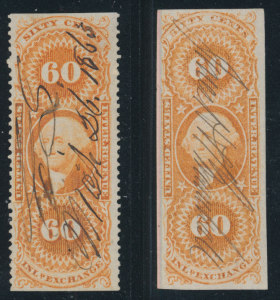The first issue revenues of the United States are some of the world’s most attractive stamps and would be far more popular among US collectors if it wasn’t for the perf, imperf, part perf problem. These stamps were issued to pay taxes on everything from bills of sale to stock and property transfers and the initial plan was to issue revenue stamps for each type of transaction. But from the first this proved impractical and any of these revenues could be used to pay any kind of tax (I’ve seen regular issues stamps too-specifically #65, 68 and 73- used on documents to pay taxes). In the rush to get these stamps to users at the start of the Civil War they were sent imperforate or sometimes part perforated though the intention all along was for the issues to be perforated just as the postage stamps of the time were.
Here is the problem with this issue. All are known perfed and many were also issued imperf and/or part perf. In nearly all cases the perforated stamps are far cheaper than the imperf and part perf ones and its easy to see how a collector with a scissors could make the varieties that he needs from the perforated stamps. The earliest revenue collectors had access to great warehouses of documents and they saw which stamps were used before they soaked them for their collections. Because of this they knew what was perf and what was imperf and what was in between. Today you really don’t know for sure unless you collect pairs to prove where the perforations were or weren’t. Most stamp collectors love certainty. Every stamp has a catalog number and a place in his collection. Uncertainty creates unpopularity and first issue revenues despite their scarcity and appeal would be for more collected if their identification were more easily certain.


